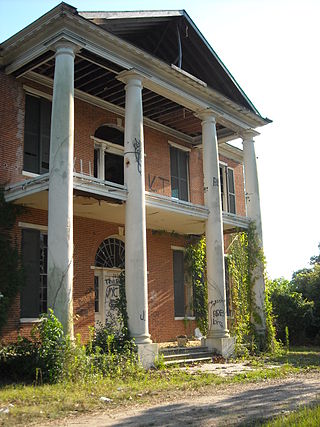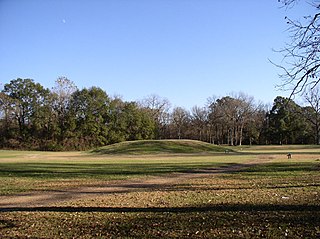
Vidalia is the largest city and the parish seat of Concordia Parish, Louisiana, United States. The population was 4,299 as of the 2010 census.

Natchez, officially the City of Natchez, is the only city in and the county seat of Adams County, Mississippi, United States. The population was 14,520 at the 2020 census. Located on the Mississippi River across from Vidalia in Concordia Parish, Louisiana, Natchez was a prominent city in the antebellum years, a center of cotton planters and Mississippi River trade.

Destrehan Plantation is an antebellum mansion, in the French Colonial style, modified with Greek Revival architectural elements. It is located in southeast Louisiana, near the town of the same name, Destrehan.

Arlington is a historic Federal style house and outbuildings in Natchez, Mississippi. The 55-acre (22 ha) property, which includes three contributing buildings, was listed on the National Register of Historic Places in 1973. It was further declared a National Historic Landmark in 1974. Following a fire that destroyed much of the main house, it was placed on Mississippi's 10 most endangered historic places for 2009 by the Mississippi Heritage Trust.

Grand Village of the Natchez, also known as the Fatherland Site, is a 128.1-acre (0.518 km2) site encompassing a prehistoric indigenous village and earthwork mounds in present-day south Natchez, Mississippi. The village complex was constructed starting about 1200 CE by members of the prehistoric Plaquemine culture. They built the three platform mounds in stages. Another phase of significant construction work by these prehistoric people has been dated to the mid-15th century. It was named for the historic Natchez people, who used the site in the 17th and 18th centuries.

Monmouth is a historic antebellum home located at 1358 John A. Quitman Boulevard in Natchez, Mississippi on a 26-acre (11 ha) lot. It was built in 1818 by John Hankinson, and renovated about 1853 by John A. Quitman, a former Governor of Mississippi and well-known figure in the Mexican–American War. It is one of Natchez's grandest Greek Revival mansions. It was declared a Mississippi Landmark in 1986 and a National Historic Landmark in 1988. It is now a small luxury hotel.

Stanton Hall, also known as Belfast, is an Antebellum Classical Revival mansion within the Natchez On-Top-of-the-Hill Historic District at 401 High Street in Natchez, Mississippi. Built in the 1850s, it is one of the most opulent antebellum mansions to survive in the southeastern United States. It is now operated as a historic house museum by the Pilgrimage Garden Club. The house was declared a National Historic Landmark in 1974; a pivotal property inside the Natchez On-Top-of-the-Hill Historic District in 1979; and a Mississippi Landmark in 1995.

The Whitney Plantation Historic District is preserved by the Whitney Institute, a non-profit whose mission is to educate the public about the history and legacies of slavery in the Southern United States. The district, including the main house and outbuildings, is preserved near Wallace, in St. John the Baptist Parish, Louisiana, on the River Road along the Mississippi River. Habitation Haydel was founded in 1752 by Ambroise Heidal, one of the many German immigrants who colonized the river parishes in the 18th century. His descendants owned it until 1860. In 1867 it was sold to businessman Bradish Johnson who renamed it Whitney.

The Houmas, also known as Burnside Plantation and currently known as Houmas House Plantation and Gardens, is a historic plantation complex and house museum in Burnside, Louisiana. The plantation was established in the late 1700s, with the current main house completed in 1840. It was named after the native Houma people, who originally occupied this area of Louisiana.

The Ormond Plantation House is a French Colonial-style, Creole plantation house located in Destrehan, St. Charles Parish, Louisiana, United States.

Stephen Duncan was an American planter and banker in Mississippi. He was born and studied medicine in Pennsylvania, but moved to Natchez District, Mississippi Territory in 1808 and became the wealthiest cotton planter and the second-largest slave owner in the United States with over 2,200 slaves. He owned 15 cotton and sugar plantations, served as President of the Bank of Mississippi, and held major investments in railroads and lumber.

Cherry Grove Plantation is a historic plantation in Natchez, Mississippi.

Elms Court is a historic mansion in Natchez, Mississippi, United States.

Lansdowne is a historic mansion that is listed on the National Register of Historic Places in Natchez, Adams County, Mississippi. It was originally built as the owner's residence on the 727-acre, antebellum, Lansdowne Plantation. The mansion and 120 acres are still owned and occupied by the descendants of the builder, who open it periodically for tours.

David Hunt was an American planter based in the Natchez District of Mississippi. From New Jersey in approximately 1800, he took a job in his uncle Abijah Hunt's Mississippi business. After his uncle's untimely 1811 death, as a benefeciary and as the executor of the estate, he began to convert the estate into his plantation empire. By the time of the 1860 slave census, Hunt owned close to 800 slaves. This was after ensuring that each of his five adult children had at least one plantation and had an approximate minimum of 100 slaves apiece. In fact, Hunt and his five adult children and their spouses owned some 1,700 slaves by 1860. He became a major philanthropist in the South, contributing to educational institutions in Mississippi, as well as the American Colonization Society and Mississippi Colonization Society, the latter of which he was a founding member.

Glenfield Plantation is a one-level historic antebellum home in Natchez, Mississippi. Glenfield was built in two distinct architectural periods on a British land grant originally deeded to Henry LeFluer by King George III. The original 500 acres grew to a 2000-acre working cotton plantation through various ownerships, circa 1774-1812 and 1845–1850. Glenfield was listed on the National Register of Historic Places in Mississippi in 1990.
The Cliffs Plantation is a Southern plantation with a historic mansion located in Natchez, Mississippi, USA.

Live Oak is a former plantation in Weyanoke, West Feliciana Parish, Louisiana, United States. The Live Oak Plantation House is one of the first houses in the Felicianas, built in 1808 with Spanish-influenced architecture, predating the American annexation of the Republic of West Florida in 1810. It is listed on the National Register of Historic Places under the name "Live Oak," as of March 11, 1977.
The Acadia Plantation was a historic plantation house in Thibodaux, Louisiana, U.S.. It was the plantation of James Bowie, Rezin P. Bowie, and Stephen Bowie. James "Jim" Bowie, served in the Battle of the Alamo. It was listed on the National Register of Historic Places on May 29, 1987. It was demolished in 2010.




















